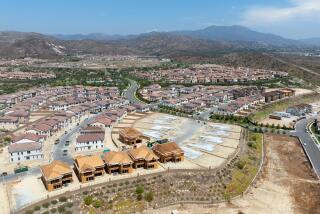Indian Artifacts Reburied Amid Criticism
- Share via
NEWPORT BEACH — Spiritual rites and modern development clashed Wednesday as the Irvine Co. reburied ancient artifacts unearthed in 1994 while building a Newport Beach housing development.
When the Irvine Co. began building the 149 Harbor Cove homes along the bluffs of upper Newport Bay, it discovered skeletal remains and artifacts, including charm stones, hunting tools and ceremony beads belonging to two tribes--the Juanenos band of Mission Indians and the Coastal Gabrieleno-Dieguno Indians. Both tribes reviewed a list of the findings and recommended their reburial as soon as possible.
The Native American Heritage Commission, which by law must be involved in any excavation or study of indigenous remains, said the developer did nothing wrong. But the Juanenos contended Wednesday that the company dismissed their requests for a traditional burial that would include a formal ceremony and the placement of the artifacts next to the remains.
“I’m tired of these guys not giving our ancestors the proper respect,” said the Juanenos’ chief, David Belardes, who said he could not attend Wednesday’s reburial.
Jim Velasques of the Coastal Gabrielenos, who was present at the procedure, said he was satisfied with the way that the Irvine Co. handled the situation.
“I can see where David [Belardes] is coming from,” Velasques said, “but there’s no way we could put the artifacts in the hands of the skeletons. It’s cost prohibitive.”
Under California Coastal Commission laws, when indigenous remains are found at a construction site, the developer is mandated to stop the project, launch an excavation that includes an archeological team, the local coroner, the Native American Heritage Commission and tribal officials.
In late 1994, the Irvine Co. began breaking ground on the housing plan in this 90-acre upper bay site sandwiched between the Hyatt Newporter and San Joaquin Hills Road. Over the course of about two years, Macko Inc. archeologists uncovered thousands of materials, said Norm Witt, vice president of the Irvine Co.’s Coastal Community Builders division. Six sites were selected for archeological examination, eventually yielding a wealth of artifacts.
Analysts spent months sifting through the discoveries, much of which turned out to be sacred pieces such as slate tools, spears, and devices resembling fishhooks and beads. Some of the findings could date back 9,000 years, Witt said.
“The best material will be curated, sent to a museum, and others will probably be used for scholarship use,” Witt said.
On Wednesday, workers hauled a load of artifacts that had been analyzed and cataloged and reburied them at locations where they were found. The remaining artifacts still being studied at labs will be buried at a later time, Witt said.
Because of Wednesday’s strong Santa Ana winds, Velasques said he did not conduct a formal burial ritual as workers laid the artifacts on top of the remains. He added that the land was blessed and a ceremony was held in previous years when the artifacts were first unearthed.
Belardes, who works as a groundskeeper for the Capistrano school district, said he will continue to demand that the Irvine Co. allow him to examine the artifacts. With about 2,000 Juanenos in Orange County, he said, the rich archeological finds should be more closely examined by a Juaneno so that they may be better preserved.
More to Read
Sign up for Essential California
The most important California stories and recommendations in your inbox every morning.
You may occasionally receive promotional content from the Los Angeles Times.













